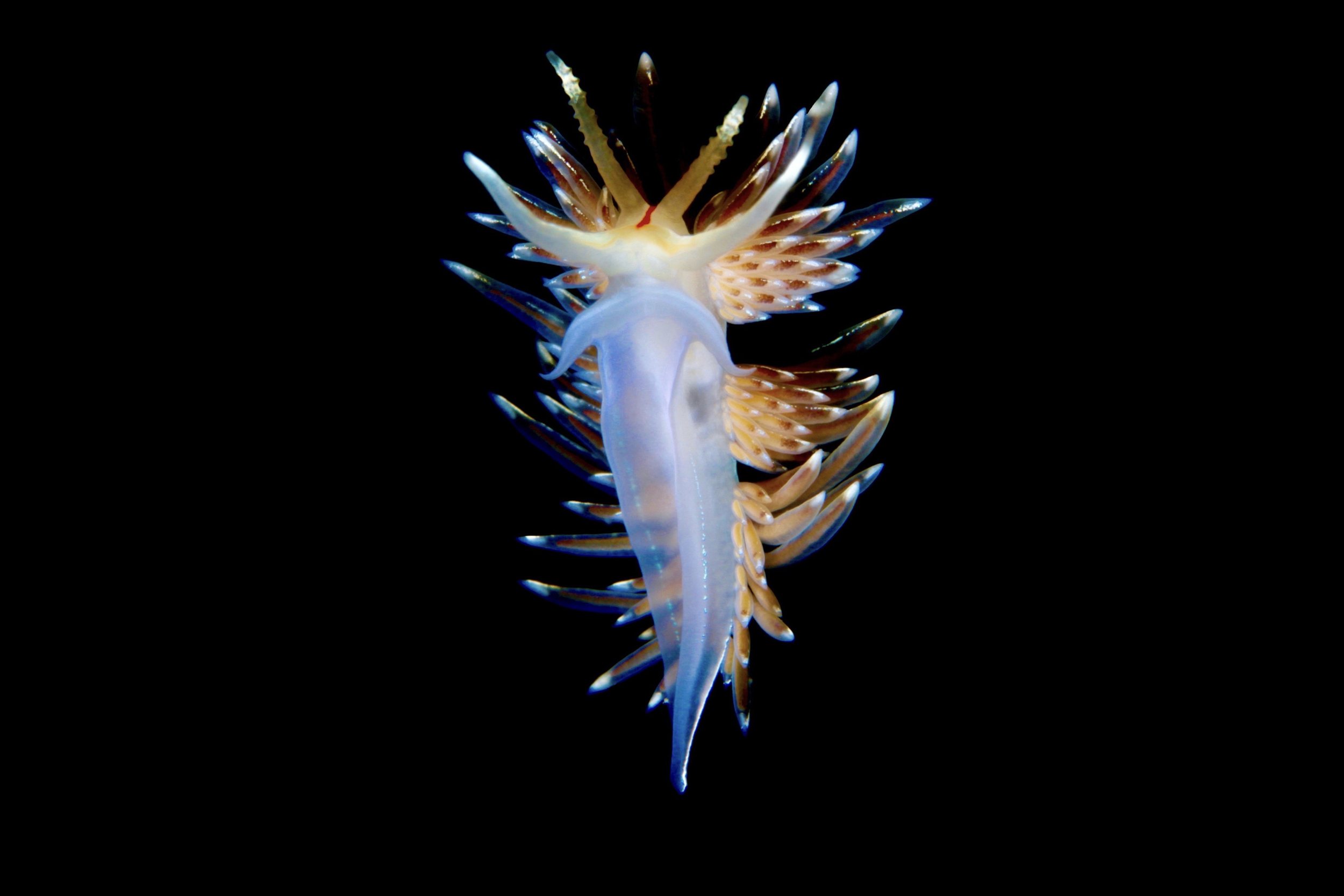Opalescent Nudibranch
Hermissenda crassicornis
On first glance, it is not quite clear what exactly a nudibranch is, especially when seen from above. Local nudibranch species are notorious for having colourful ‘cerata’ protruding from their backs, which often makes it difficult to understand their anatomy.
Nudibranchs are a very special group of shell-less marine snails, known worldwide for their bizarre shapes and colours. the Latin word, ‘nudibranch’ means ‘naked gill’ in english, referring to the fact that nudibranchs breathe through un-armoured, gill-like structures on their backs [1].
In the photograph below, which this artwork is inspired by, imagine you are seeing this Opalescent nudibranch from beneath, with its head turned slightly downward to ‘look’ back at you.
October 2017. An Opalescent nudibranch drifting along in the currents above a lush eelgrass bed in Central Saanich, B.C. This animal was free-floating about 6 feet off the seafloor.
📖 Description 📖
While nudibranchs are known worldwide for their aforementioned characteristics, the nudibranchs of British Columbia are additionally known for their large size. British Columbia is home to some very large species, several of them among the largest in the world. The Opalescent nudibranch, arguably one of the most well known, is ironically one of the smallest. This little nudibranch only grows to just over 8 centimeters in length. This is relative to several others, such as the Giant dendronotus and Orange-peel nudibranchs, who are capable of growing to over 30 centimeters in length [2] [3].
While we from the surface world admire the vivid colours of this species, these colours actually signal to predators that the nudibranch is not safe to eat. Opalescent nudibranchs will concentrate bad-tasting chemicals and stinging-cells from its prey in the cerata on their backs as a defence . This survival technique is known as aposematic colouration, and is the same strategy used as poison dart frogs in tropical rainforests [4].
July 2022: An adult Opalescent nudibranch shows off its colourful cerata. This individual was particularly large, potentially up to 4cm in length! Photographed in Barkley Sound, B.C.
🌎 Distribution 🌎
The Opalescent nudibranch (Hermissenda crassicornis) has been documented from the Gulf of Alaska down to Northern California. It was thought that this species’ range extended down into Baja California, however in 2016 it was discovered that Opalescent nudibranchs found south of Northern California actually belong to a separate species entirely.
Hermissenda opalescens is found from Northern California to Baja California. A third similar species is found in Japan & Korea, known as Hermissenda emurai [5].
Distribution of the Opalescent nudibranch, Hermissenda crassicornis. Suitable habitat depicted in red.
🏝 Habitat 🏝
The Opalescent nudibranch has a very limited depth range, only being found from the Intertidal zone down to 35 meters deep. Several factors may limit the nudibranch to these depths, such as availability of food [4].
As various colours of light disappear as you descend deeper into the ocean, it is possible that the bright colours of the nudibranch cannot be seen at depth and is unable to successfully warn predators of its bad taste.
Depth of suitable habitat for the Opalescent nudibranch, Hermissenda crassicornis. Suitable habitat depicted in red. Not to scale.
Within its depth range, this species of nudibranch can be found in just about any habitat, including eelgrass beds, kelp forests, rocky reefs, and the rocky intertidal [4].
One peculiar habitat that Opalescent nudibranchs seem to particularly enjoy is the underside of docks and harbours. During the spring, summer, and fall, it is quite common to see Opalescent nudibranchs crawling along dock pilings hunting for food.
🌊 Diet 🌊
The reason Opalescent nudibranchs are such a big fan of harbours is likely due to the types of organisms that live there. Every harbour is different, however many are home to a wide range of animals that the Opalescent nudibranch eats. This species will target sea anemones, hydroids, jellies, and tunicates as prey.
June 2016: A cluster of Lightbulb tunicates, Clavelina dellavallei in Saanich Inlet, B.C. This is one such tunicate species that the Opalescent nudibranch may eat.
On occasion, Opalescent nudibranchs will fight when coming in contact with one another. In some cases, naturalists have documented the winner of these fights eating the loser [4]. A larger specimen can be seen chasing a younger individual in the photo below:
July 2022: An adult Opalescent nudibranch on the move, hunting a smaller nudibranch, quite possibly with the intention of capturing and eating it. A whorl of nudibranch eggs is also visible at the top left. Photographed in Barkley Sound, B.C.
🐌 Life Cycle 🐌
Like many nudibranchs, this species has a very quick life cycle. Opalescent nudibranchs generally live for anywhere between four months and one year.
Nudibranchs are hermaphrodites, meaning they are all both male and female at the same time. When two nudibranchs mate, they each exchange sperm, and both animals end up with fertilized eggs. These eggs are later laid in spiralling loops of sausage-like bundles on rocks, kelp, or eelgrass [4]. After only several weeks, the eggs hatch into a larvae known as a veliger. This veliger feeds on plankton, and after several developmental stages, it settles onto the bottom to begin its life as a nudibranch [6].
June 2017: The egg mass of an aeolid nudibranch, quite possibly belonging to an Opalescent nudibranch. Photographed in Victoria, B.C.
📚 References 📚
[1] Britnell, J. & Britnell, K. (2019, March 12). What is a Nudibranch? Canadian Geographic. https://www.canadiangeographic.ca/article/what-nudibranch-meet-high-fashion-models-ocean-depths
[2] Fretwell, K & Starzomski, B. (2014). Giant nudibranch. Central Coast Biodiversity. https://www.centralcoastbiodiversity.org/giant-nudibranch-bull-dendronotus-iris.html
[3] Fretwell, K & Starzomski, B. (2014). Orange-peel nudibranch. Central Coast Biodiversity. https://www.centralcoastbiodiversity.org/orange-peel-nudibranch-bull-tochuina-tetraquetra.html
[4] Fretwell, K & Starzomski, B. (2016). Opalescent nudibranch. Central Coast Biodiversity. https://www.centralcoastbiodiversity.org/opalescent-nudibranch-bull-hermissenda-crassicornis.html
[5] Lindsay, T. & Valdés, Á. (2016). The Model Organism Hermissenda crassicornis (Gastropoda: Heterobranchia) Is a Species Complex. PLoS ONE, 11(4): e0154265. https://doi.org/10.1371/journal.pone.0154265
[6] Hadfield, M. G. (1963). The Biology of Nudibranch Larvae. Oikos, 14(1), 85–95. https://doi.org/10.2307/3564960







